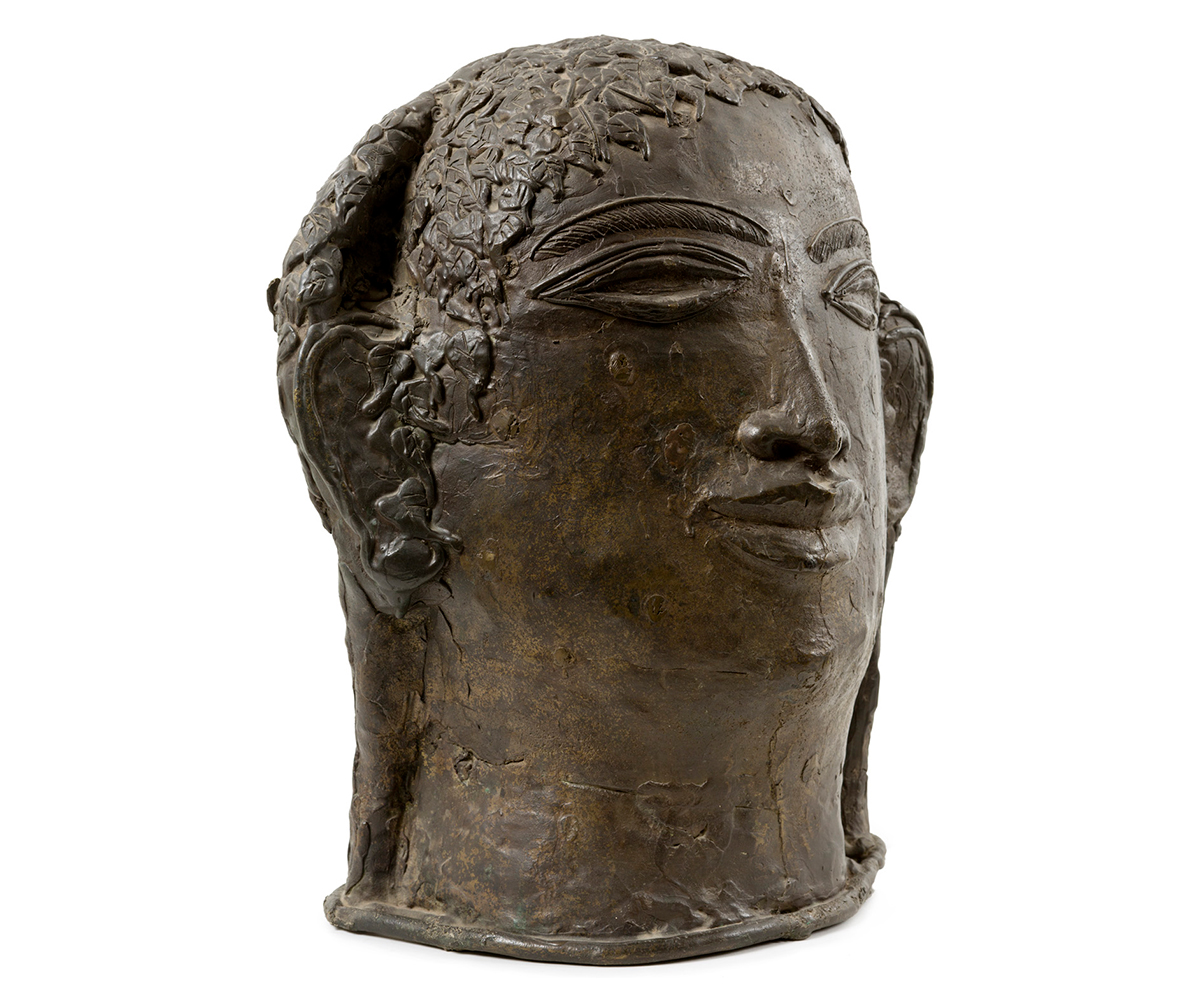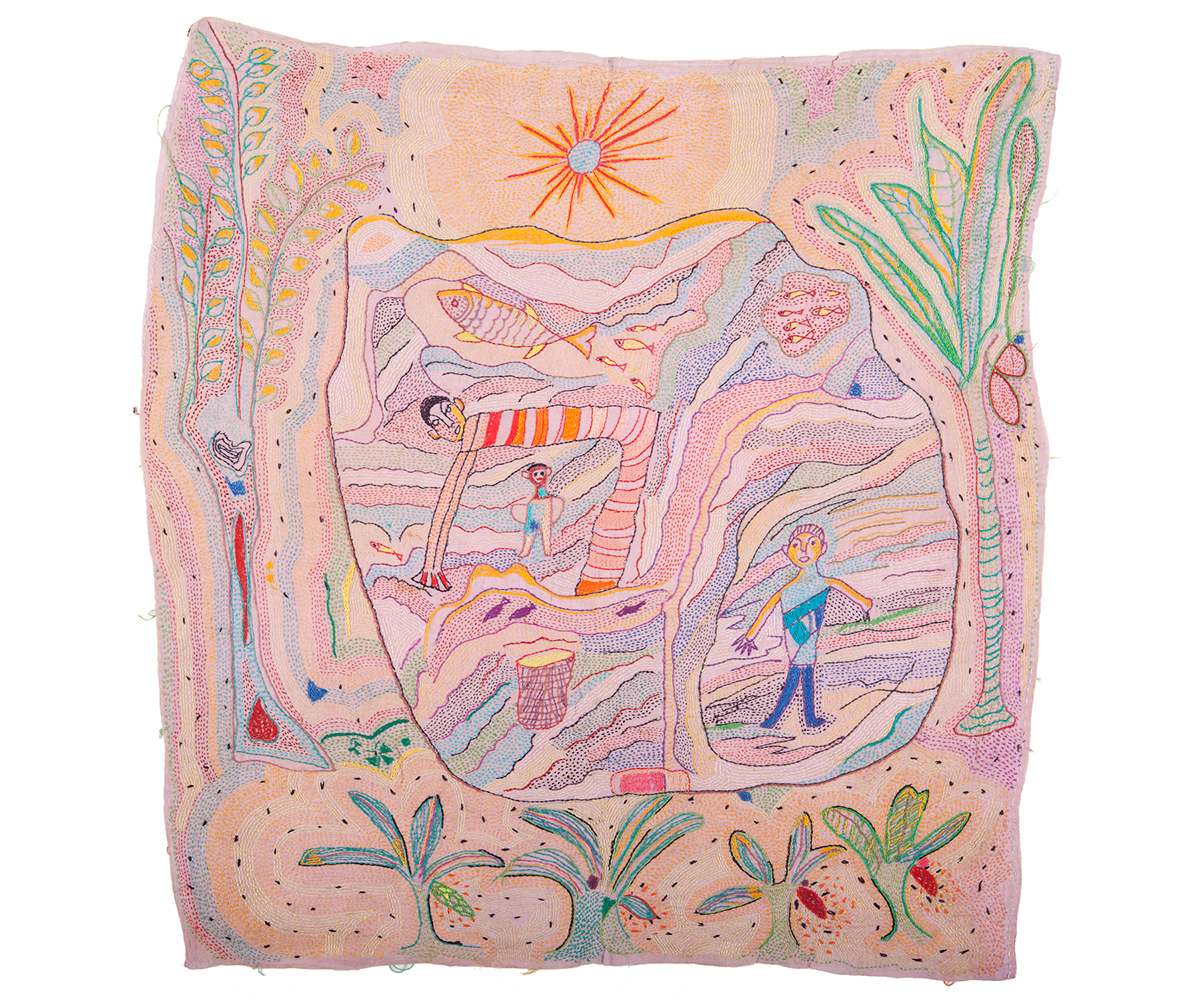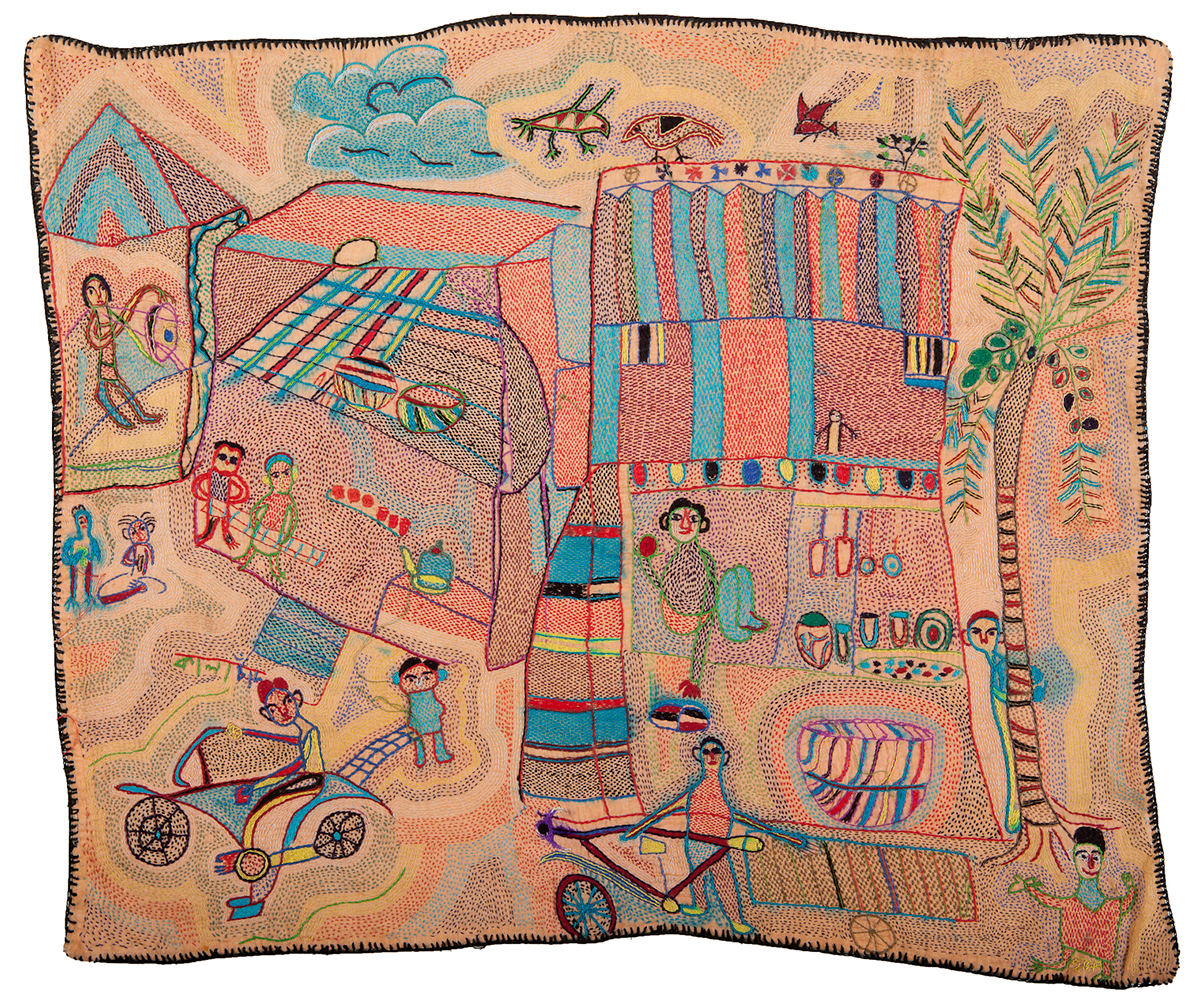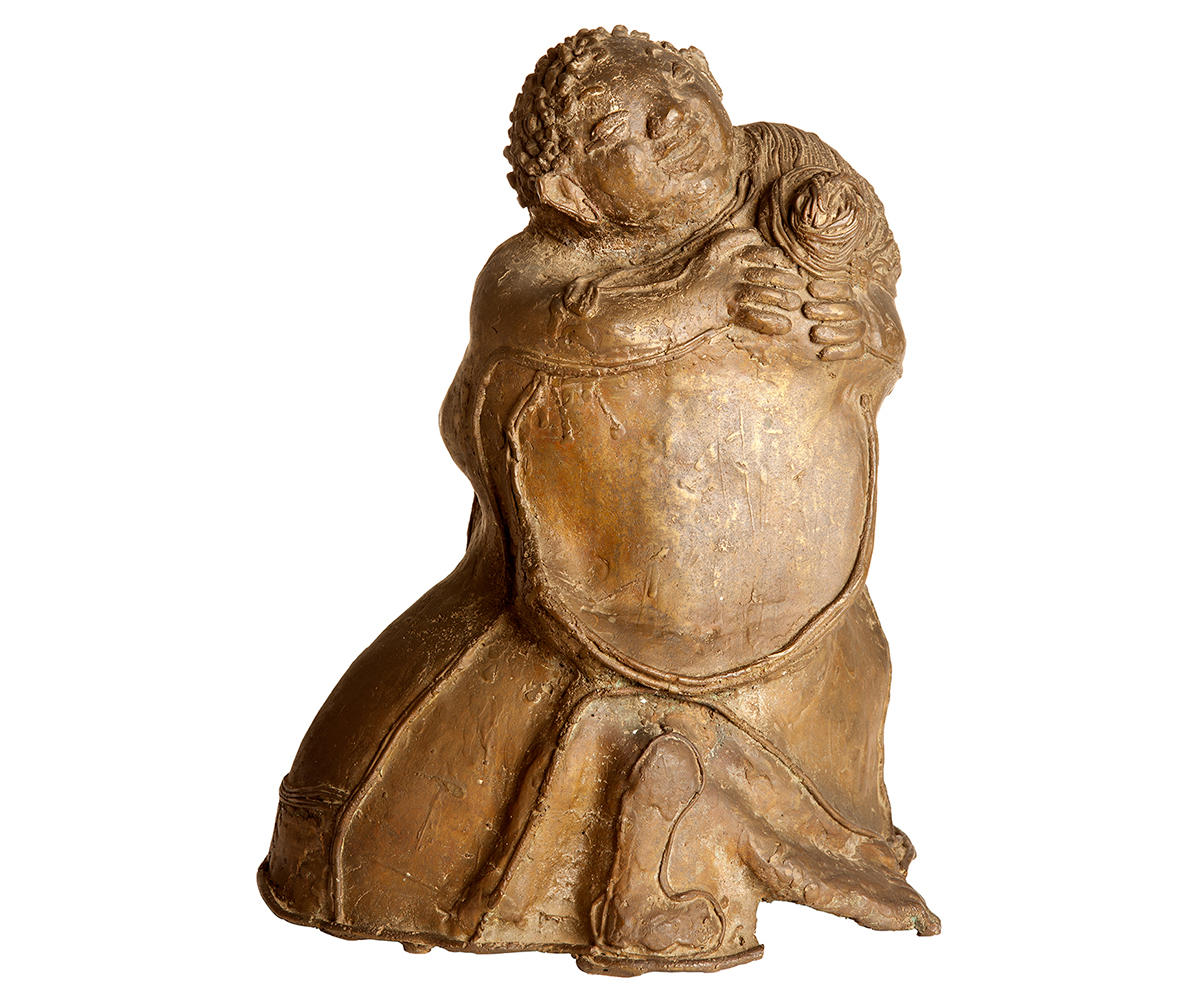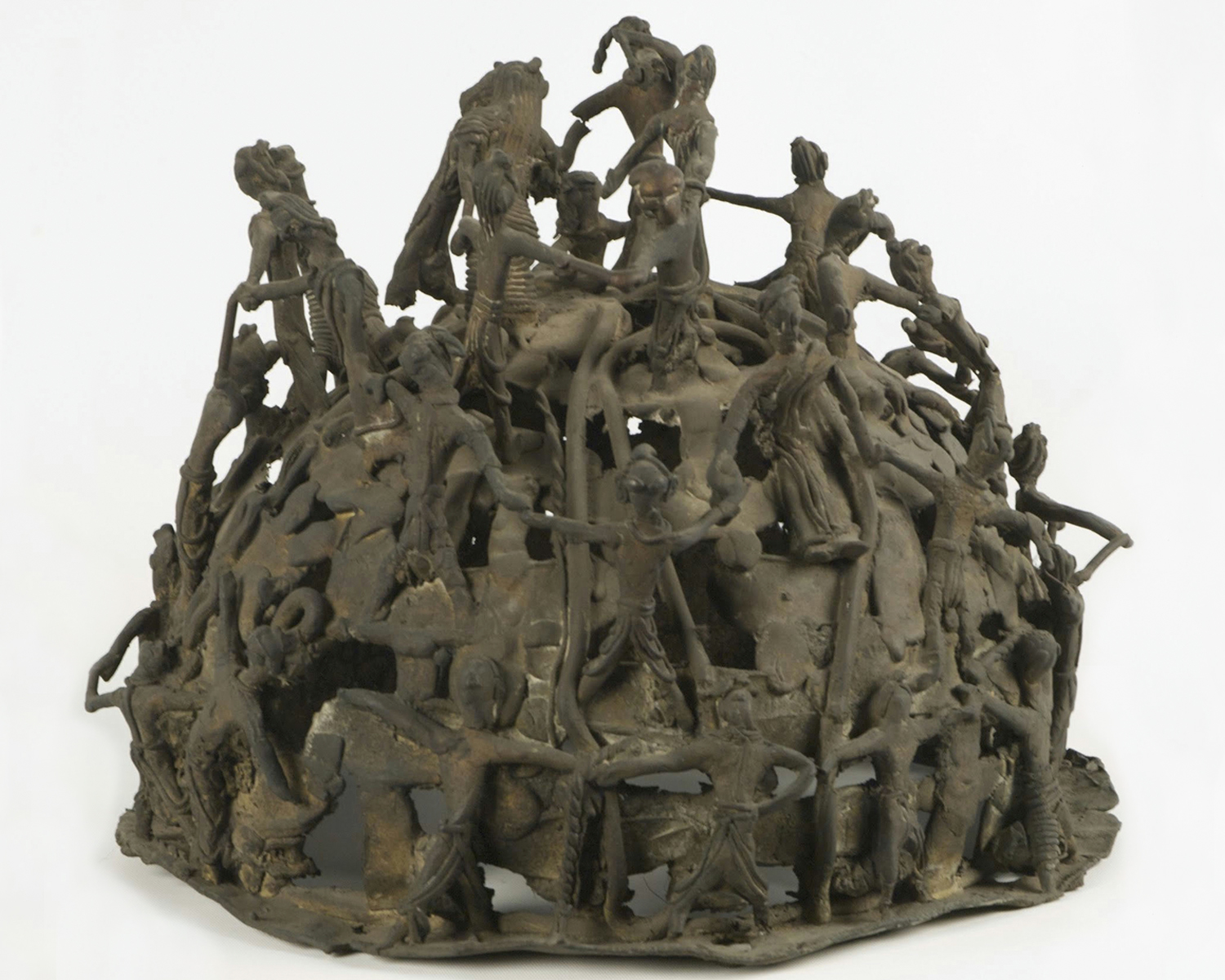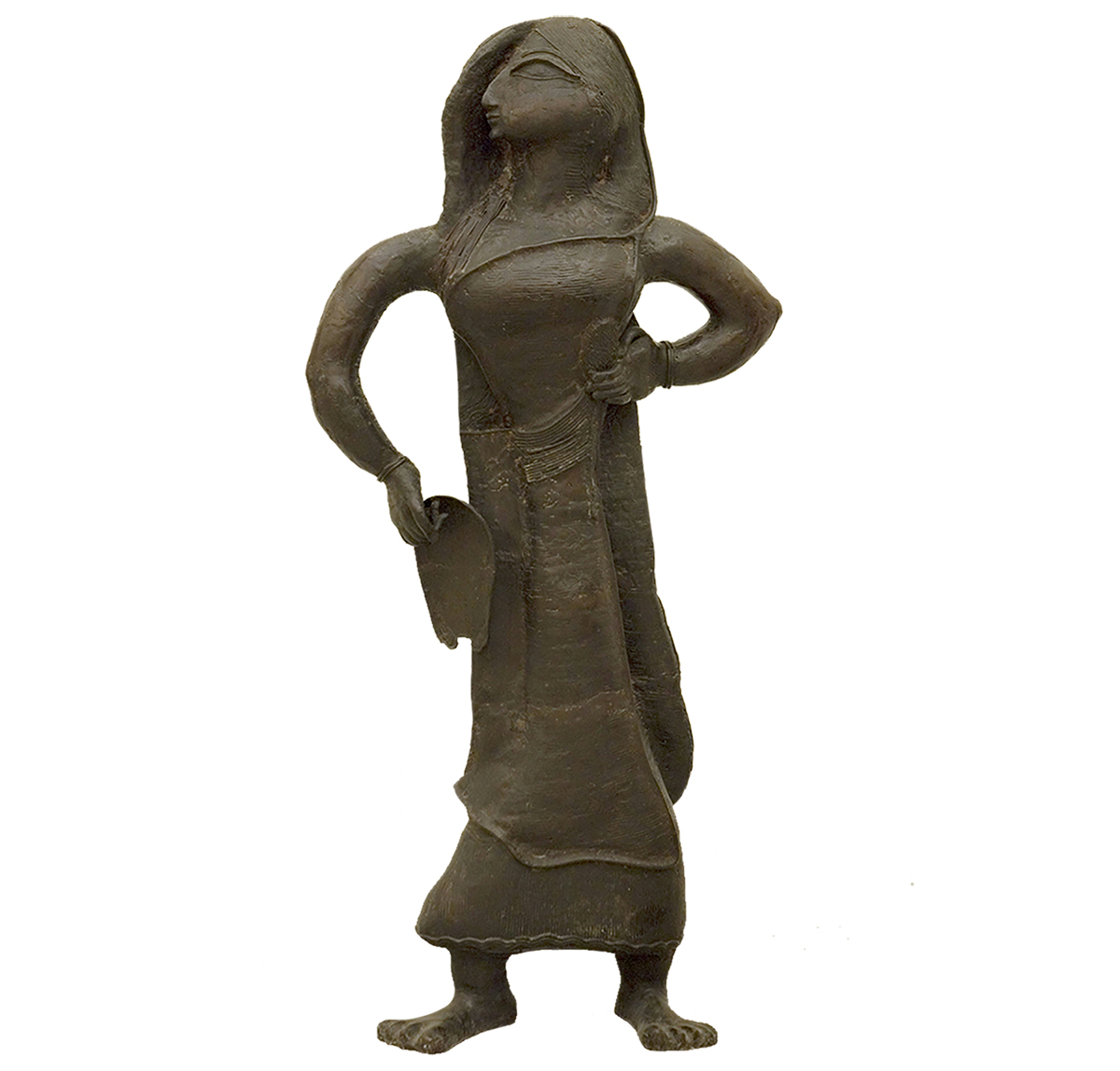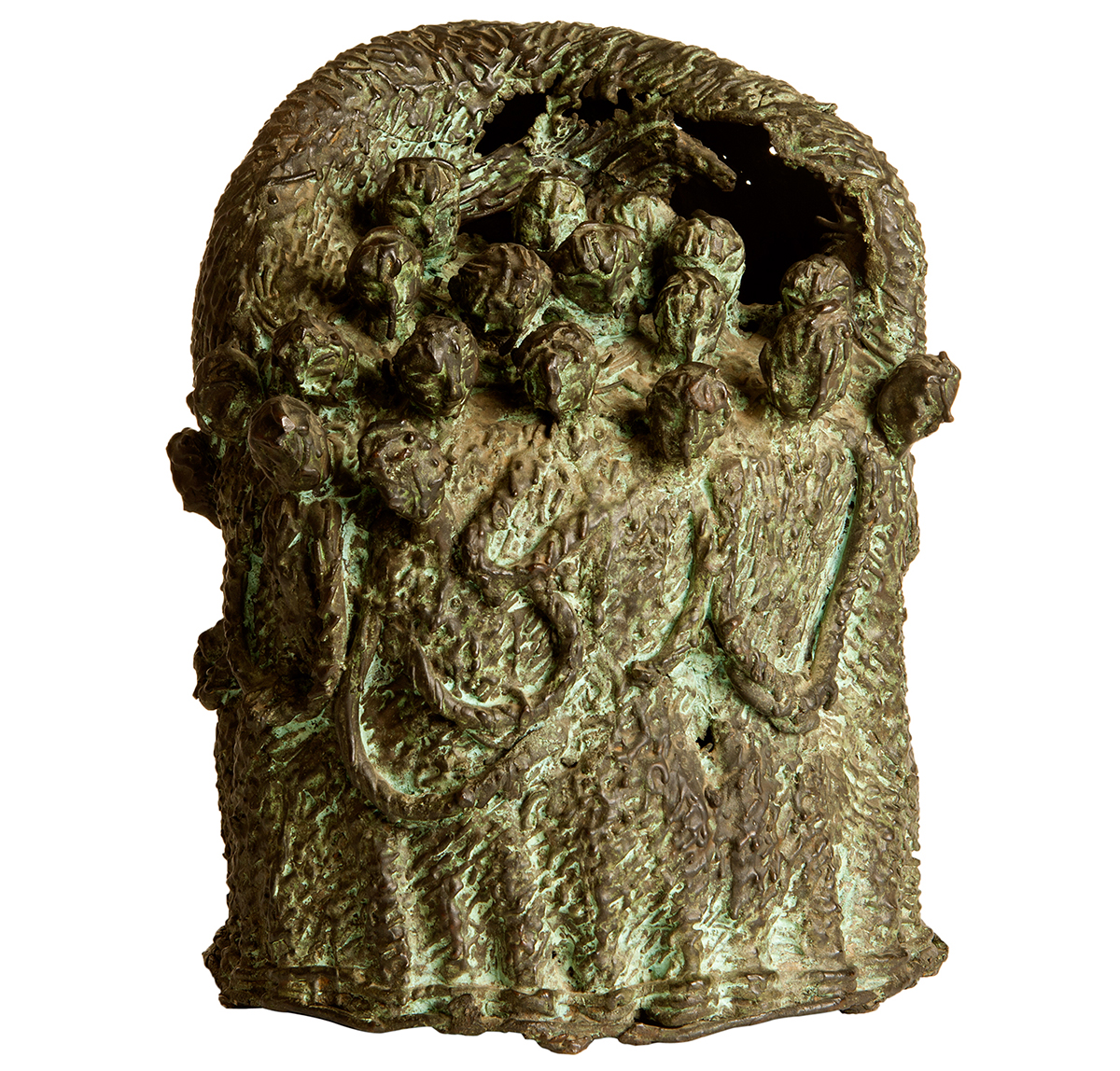ARTICLE
Meera Mukherjee (b. 1923; d. 1998)
A sculptor and researcher, Meera Mukherjee was an Indian Modern artist known for her bronze sculptures, which draw on the Dhokra craft techniques of indigenous metalworkers in central and eastern India. While her work was shaped by her immersive research and documentation of metal artisanship, particularly of the Gharua community in present-day Chhattisgarh, her subjects centre on humanist themes of labour, mass movements and quotidian activities observed in rural as well as urban India. Characterised by their rich surface textures and dynamic forms, her sculptures depict individuals or groups engaged in a range of activities, from weaving, rowing a boat or construction work, to protesting, playing an instrument, travelling in a bus or simply reflecting. Her large-scale works in particular, influenced by primitive deified images, reflect Mukherjee’s preoccupation with the human spirit that is elevated through and beyond the mundane. She also worked with painting, terracotta, ceramic and kantha embroidery.
Mukherjee was born in Calcutta (now Kolkata), where she began her artistic training in painting methods associated with the Bengal School, such as the wash technique, at classes run by the Indian Society of Oriental Art. She was then trained in the Academic Realist style of painting, as well as graphic design and sculpture, at the College of Art, New Delhi (then a department under Delhi Polytechnic). During the early 1950s she worked with the visiting Indonesian artist Affandi at Shantiniketan, who became a significant early influence on her work. Soon after her first solo exhibition in 1952, Mukherjee received a scholarship to attend the Akademie der Bildenden Künste (Academy of Fine Arts) in Munich, Germany, where she shifted her focus from painting to sculpture soon after enrolling. In her travels during this period, she met English sculptor Henry Moore, whose approach to form would influence her own. At the same time, one of her Munich academy mentors, Toni Stadler, urged her to look towards the art and traditions of India for inspiration rather than those of the West — advice that proved pivotal in Mukherjee’s career.
After her return to India in 1956, and following a period of teaching, Mukherjee embarked on travels to explore sculptural traditions in rural and tribal parts of the country, beginning in the Dandakaranya region covering Bastar, Chhattisgarh and other parts of east-central India. In the sixties and seventies she travelled extensively across India and Nepal, spending two years amongst the indigenous Gharua community of Bastar, known for their Dhokra metal crafts using the lost wax technique. A dedicated and prolific diarist, Mukherjee meticulously recorded her observations of metal casting techniques as well as notes on everyday life and traditions in the regions she travelled. Her research was supported in part by the Anthropological Survey of India, where she also served as Senior Research Fellow from 1961 to 1964, producing surveys and reports on various Indian metalwork traditions. Her work culminated in a number of essays and books offering detailed descriptions of metal casting processes and their regional variations, particularly the lost-wax technique, as well as glimpses into the lives of traditional metalwork practitioners. These include Gharuas: A Metal Artisan Group and Their Art (1974), Folk Metal Craft of Eastern India (1977) and In Search of Viswakarma (1994), as well as the comprehensive Metal Craftsmen of India (1978).
While her research enabled her to develop a deep understanding of metalworking techniques, she also absorbed aspects of a spiritual worldview from the communities she was studying, particularly during her immersive apprenticeship among the Gharuas. These influences shaped her own ongoing artistic practice. While the images she encountered during her travels were generally small, Mukherjee conceived large bronze sculptures depicting human figures, often life-size or even larger. These figures had to be cast using separate moulds in sections that were later welded together. She also modified the lost wax process to account for the weight of the clay core in these moulds and prevent the structure from collapsing. These were fired in kilns in Narendrapur village near Kolkata, and a chemical patina applied to some of the finished sculptures to give them a green hue. As in the indigenous sculptures, Mukherjee’s sculptures consciously retain the uneven surfaces from the casting process and show the seams where the sections are joined together. Such aspects in her work were informed by the distinction she drew between classical metal work and indigenous metal sculpture and ritual vessels.
As an anthropologist-artist commissioned by the State to document the crafts of indigenous communities, she examined her own cultural position against wider artistic trends such as Primitivism in Europe, and remained preoccupied with the distinctions and relationship between the artist and the artisan. She also became influenced by the social reformer and activist Kamaladevi Chattopadhyay and the sculptor Prabhas Sen.
The heroic stance of the Bastar ritual sculptures, particularly the Gharua images of gramadevatas or deified local heroes and gods, inspired Mukherjee’s figures of ordinary working individuals, often cast larger than life and in a spirit of homage. The first of her large sculptures, He Who Saw, was conceptualised in 1965 and cast in bronze sometime between 1966 and 1968. The 2-metre-tall sculpture of a human figure, based on a primitive deity image she came upon in Bastar’s forests, is composed of eight parts welded together at the figure’s joints. Mukherjee’s best-known work, the monumental Ashoka at Kalinga, was made in 1972. Depicting the emperor Ashoka’s renunciation of violence in the aftermath of the bloody Kalinga War, it was cast in response to the political violence in India during the late sixties.
Later in her career, Mukherjee created smaller-scale pieces. In place of the isolated figures of her monumental works, these sculptures often depict lively scenes with groups of people, expressing themes of labour as well as social movements. The figures of Earth Carriers and The Cablemen form tributes to the anonymous labourers engaged in building urban infrastructure. Pieces such as The Basketweaver, Pankhawala, Weaving, Spirit of Daily Work (1965), Toilers I and II (1981) depict the gestures of various rural and urban occupations. In works such as Railway Station (1981) and Minibus (1982), Mukherjee depicts the daily movements of the masses. Andolan is a personal yet political work referencing student protests against poor infrastructure at the Government College of Art and Craft in Kolkata, where Mukherjee taught. In contrast, images such as The Thinker (c. 1980) and her portraits of Nirmal Sengupta and her music teacher Binode Babu express a meditative manner. Her depictions of musicians and performers also include bronze renderings of Baul singers, and works such as Cosmic Dancer (1982), Melody and Rudra Veena Player. In much of her work she retained the distinctive Dhokra motifs of small beads or pellets and thread- or cable-like lengths of bronze cast along the sculpture surface, using them not only as figurative elements but to create visual rhythm and gestural or directional energy, similar to brushstrokes or lines in a painting. Some scholars have traced the rhythm and dynamism of Mukherjee’s sculpted forms to her training in Hindustani classical music.
In her final years Mukherjee travelled often to the Himalayas, visiting Ladakh, Lahaul and Spiti. She returned to monumental sculpture with Seated Buddha (1997), created in sixty-four sections. Left unfinished, the 4.3-metre-tall work was fired after her death and installed facing Mount Kanchenjunga among the Himalayan hills.
While her personal artistic practice was largely solitary, Mukherjee is also known for her decades-long engagement with underprivileged communities, particularly children, women and textile artisans. To support young women in the areas surrounding her workshop in suburban Kolkata and help preserve the kantha craft of household embroidery, she commissioned them to render in embroidery several drawings and paintings made by young schoolchildren. These ‘stitched paintings’ — as they were described by Sengupta, a scholar and Mukherjee’s lifelong friend — depict human figures, animals, plants and trees, huts, and village landscapes represented in a distinctively childlike style, in compositions that also echo the tribal art idiom. Between 1986 and 1990 Mukherjee worked with unemployed traditional carpet makers in northern West Bengal and Muzaffarpur, Bihar, to have these embroidered pieces made into carpets. She directed the income from the sale of these pieces to the artisan communities as a way of supporting their craft practice. Now held in important private collections, some of these works were exhibited in posthumous exhibitions such as Stitched Paintings at Galerie 88, Kolkata (2023), Common Ground: Meera Mukherjee and the Carpet Makers of Muzaffarpur, curated by Chatterjee & Lal at 47/A, Mumbai (2022), and as part of Adip Dutta’s Nestled at Experimenter, Kolkata (2021). Mukherjee also wrote and illustrated children’s books such as Little Flower Shefali and Other Stories and Kalo and the Koel, published in 1998.
A retrospective tracing Meera Mukherjee’s artistic practice from 1963 to 1983 was held in Mumbai in 1983 at the Jehangir Art Gallery. Her work is displayed at art and cultural institutions such as the Museum of Art & Photography (MAP), Bangalore and the Kiran Nadar Museum of Art in New Delhi. Her sculpture Ashoka at Kalinga is currently installed on the grounds of the ITC Maurya Sheraton Hotel in New Delhi.
Mukherjee received the President’s Award for metal craftsmanship in 1968, the Abanindra Prize in 1981 from the Government of West Bengal, and the Padma Shri in 1992. She was also an Emeritus Fellow of the Indian Government between 1984 and 1986.
Mukherjee died in 1998 at the age of 75.
Bibliography
Borah, Jahnabee. “The Pioneering Artist Who Combined Kantha and Carpets.” Mint Lounge, December 6, 2022. Accessed August 8, 2023. https://lifestyle.livemint.com/fashion/trends/the-pioneering-artist-who-combined-kantha-and-carpets-111670148036526.html.
D’Mello, Rosalyn. “The Afterlives of Stitches.” Open, February 12, 2021. Accessed August 8, 2023. https://openthemagazine.com/art-culture/the-afterlives-of-stitches/.
Dutta, Adip. “Stitched Paintings.” Matters of Art. Accessed August 8, 2023. https://mattersofart.blogspot.com/2023/05/stitched-paintings-exhibition.html.
Farooqi, Anis. “Mukherjee, Meera.” In The Dictionary of Art, edited by Jane Turner, 22: 267–78. Grove. London; New York: Macmillan Publishers Limited, 1996.
Gardner, Helen, and Fred S. Kleiner. Gardner’s Art Through the Ages: Non-Western Perspectives. 13th ed. Boston: Wadsworth/Cengage Learning, 2010.
Mitter, Partha. Art and Nationalism in Colonial India 1850–1922: Occidental Orientations. Cambridge: Cambridge University Press, 1994.
Sen, Geeti. “Icons Made Human: Meera Mukherjee.” Namasté Magazine, 2018.
Sen, Geeti. Image and Imagination: Five Contemporary Artists in India. Ahmedabad; Middletown, New Jersey: Mapin Publishing; Grantha Corporation, 1996.
Sunderason, Sanjukta. “Sculpture of Undulating Lives: Meera Mukherjee’s Arts of Motion.” Aziatische Kunst 50, no. 2 (2020): 54–66.




